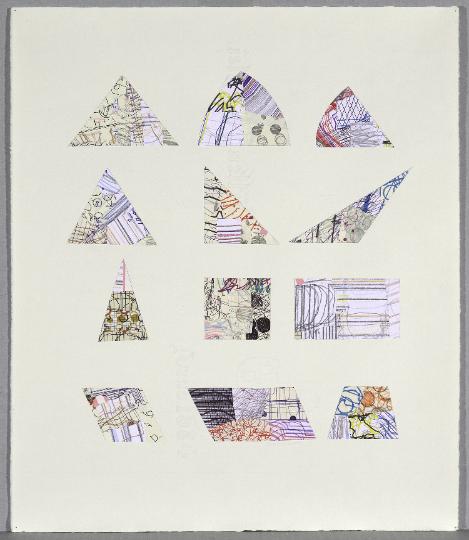- Space Odysseys
Brinsley Tyrrell, Austin Thomas at William Busta
A young tree addresses its slim, white trunk to the breadth of a field -- one strikingly simple yet dramatic vignette
among many, as Brinsley Tyrrell re-imagines the dialogues of woods and glades, lakes and the flat or hilly sweep of
northern Ohio’s plowed lands. The natural world speaks in the languages of chemistry, geology, and weather, and
Tyrrell’s large enamel on steel landscapes, cooked at more than a thousand degrees in a large oven-style kiln, evoke
the raw ferment of the scenes he depicts. The results are a sculptor's paintings, which not only flow parallel with the
world, but merge with it.
When British-born artists Brinsley and Lilian Tyrrell moved to an isolated farmhouse near Ravenna in 1975 they
began what was to become an intimate acquaintance with the surrounding lands. Brinsley, who taught as a professor of
art at Kent State University for nearly thirty years, is known for a diverse body of work that ranges from the large-scale
bronze “Waywood Wall” on CWRU’s campus, to the stone “Behind the Brain” at KSU. Then there’s the series of quietly
beautiful pastel drawings, exhibited at SPACES Gallery twenty years ago.
These last were sketches of the Ravenna farm, which eventually served as inspiration for the current series of
landscape reveries. The initial five enamel works, measuring 3’ by 5’, were created in 2007 as decorative panels for the
West 117th RTA station in Lakewood on Cleveland’s west side. The current pieces are a further, lush elaboration of
similar descriptive visual themes. They remember the conventions of impressionist landscape, eventually melting into
rippling overall patterns and textures, reminiscent of the Postimpressionist approaches of Vuillard or Bonnard. Yet, like
Charles Burchfield's synesthetic compositions which also depicted Ohio's Woods and fields, they stake out their own,
dream-like, psychological territory. Tyrrell's very physical, jewel-like surfaces present visions that seem refracted
through the darkness of secret places, remembering days that lie buried, but still shine with the luminous veins of past
seasons.
Concurrently on display in Busta’s narrow Print and Drawing room are a group of engaging small collage/drawing works
by Austin Thomas. These deceptively delicate studies, caught sometimes in the act of unfolding against or through the
gridded skin of a graph paper background, explore enduring thoughts about the speciation of drawing and sculpture.
And like Tyrrell’s enamel studies, they’re all about the magic of placement, and the mutable margins stretching between
actual and imaginary terrains.
Based in New York, Thomas has exhibited at White Columns and The Drawing Center among other venues. In 2005
the Corcoran Museum in Washington DC showed 28 examples of her ongoing collage series, combined with wooden
three dimensional structures she calls “social sculpture,” in homage to Joseph Beuys’s famous formulation and the idea
that social systems add up to (or can be rearranged to constitute) one great work of art. Her 2005 “Free Form Perch” is
ten by nine feet in circumference and five feet high. The five concentric bench-like tiers unwind upward to a single
topmost seat. Another of Beuys’s dictums was “Everyone is an artist.” Structures like Thomas’ bench or her recycled
plastic “Double Lounger” (which is something like a deckchair built for two) and her extensive series of “Perch” works,
give people a chance to participate in her work, becoming artists in a way, or even (briefly), art itself. Also influential
has been the “anarchitecture” of 1970’s Situationism-inspired artist Gordon Matta-Clark, whose version of
detournement involved the alteration of decaying inner city buildings. By slicing away sections of wall and opening up
urban vistas he transformed and extended the history of abandoned places and their residual contents.
Thomas collects rulers, which she cuts and shapes so that they can be used to make crooked lines. “Perfection is the
booby prize of life,” she remarks, and her pseudo-geometric dodecahedron in “Perspective Study,” is, as one might
expect, non-Euclidean (though in this case the outlines of her figure are pretty straight). Thomas builds an approximate
order on the basis of chaos, using cut fragments of paper covered with scribbles, letters, and snatches of drawings. A
dialogue between random disorder and formal simplicity (Thomas is also a fan of Ellsworth Kelly’s abstract clarity)
ensues, like a song teetering at the brink of noise.
In these works sense falls apart just when it begins to fall together – they're sketches of the way life is, as organisms
(like us) negotiate their desires across the permeable borders of being. In one of her blog posts Thomas writes, “Next
up, experiments in and with new and different, reformed, informed and all encompassing forms of selfhood (folded,
presented, performed, baked, butted, and drawn crooked).”
-- Douglas Max Utter
Ohio Lands Forever / Brinsley Tyrrell
Recent Drawings / Austin Thomas
June 4 - July 31, 2010
William Busta Gallery
2731 Prospect Ave., Cleveland, OH 44115

The Way Beside the Apple Tree
Brinsley Tyrrell 2009
Brinsley Tyrrell 2009
Plain Geometry, Austin Thomas
